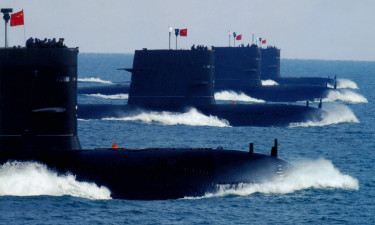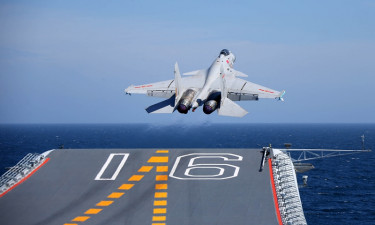From barely a mid-sized navy with obsolete Soviet-era ships at the turn of the millennium, the People’s Liberation Army Navy (PLAN) has emerged as the second largest in the world, only behind its main Pacific rival, the US. With naval power firmly at the center of its global ambitions, China’s navy will only grow stronger over the coming decades, representing the biggest challenge to US naval supremacy since the 1970s.
Admiral Zheng He’s treasure fleet of the 15th century was one of the largest pre-industrial navies the world had ever seen but subsequent inward-looking dynasties abandoned any efforts to remain a global naval power. As a result, China fell pray to the military and technological superiority of the European powers in the 18th and 19th centuries. The rise of Japan as a major industrial and naval power proved particularly traumatic as China was unable to prevent Japan’s invasions in 1931 and 1937 after which much of China’s coast came under Japanese control.
The Chinese navy played a negligible role in World War II and many of its ships defected to Taiwan at the end of the Civil War in 1949. During the early years of the Cold War, there was little interest to build a powerful navy although the PLAN did evolve into a relatively sizeable force albeit one that remained primarily armed with obsolete Soviet-designed ships and submarines. By the 1980s, however, some glimpses of increasing naval sophistication became evident, notably the introduction of its first ballistic missile submarines. By the turn of the millennium, the PLAN was in the midst of a full-scale modernization and had turned into the world’s third largest.
The PLAN’s expansion in the 21st century has been unprecedented, rivalling that of the Soviet navy in the 1970s and the German navy in the 1910s. This has sparked fears of a naval arms race and has forced the US Navy to make a highly publicized pivoting of its naval assets towards the Pacific. A 2004 White Paper also spelled out the priority that would be given to the PLAN in order to turn it into a true blue water fleet capable of regional (if not global) power projection and able to deny the US Navy its established supremacy in the Western Pacific. Most recently, the PLAN has introduced cruisers and aircraft carriers and is building new classes of submarines that are narrowing the (still significant) technological gap which exists with the West. By and large, the continued expansion of the PLAN will undoubtedly be the most significant change in the balance of naval power, if not geopolitical power as a whole, in the 21st century.
Admiral Zheng He’s treasure fleet of the 15th century was one of the largest pre-industrial navies the world had ever seen but subsequent inward-looking dynasties abandoned any efforts to remain a global naval power. As a result, China fell pray to the military and technological superiority of the European powers in the 18th and 19th centuries. The rise of Japan as a major industrial and naval power proved particularly traumatic as China was unable to prevent Japan’s invasions in 1931 and 1937 after which much of China’s coast came under Japanese control.
The Chinese navy played a negligible role in World War II and many of its ships defected to Taiwan at the end of the Civil War in 1949. During the early years of the Cold War, there was little interest to build a powerful navy although the PLAN did evolve into a relatively sizeable force albeit one that remained primarily armed with obsolete Soviet-designed ships and submarines. By the 1980s, however, some glimpses of increasing naval sophistication became evident, notably the introduction of its first ballistic missile submarines. By the turn of the millennium, the PLAN was in the midst of a full-scale modernization and had turned into the world’s third largest.
The PLAN’s expansion in the 21st century has been unprecedented, rivalling that of the Soviet navy in the 1970s and the German navy in the 1910s. This has sparked fears of a naval arms race and has forced the US Navy to make a highly publicized pivoting of its naval assets towards the Pacific. A 2004 White Paper also spelled out the priority that would be given to the PLAN in order to turn it into a true blue water fleet capable of regional (if not global) power projection and able to deny the US Navy its established supremacy in the Western Pacific. Most recently, the PLAN has introduced cruisers and aircraft carriers and is building new classes of submarines that are narrowing the (still significant) technological gap which exists with the West. By and large, the continued expansion of the PLAN will undoubtedly be the most significant change in the balance of naval power, if not geopolitical power as a whole, in the 21st century.
There are currently 40 entries, data on 0 warship types, and 668 individual warships in the registry.

They might be noisy right now, but expect China's submarine fleet to gradually catch up.

China knows that it will need naval air power if it has any hope of contesting the Pacific against the US Navy.